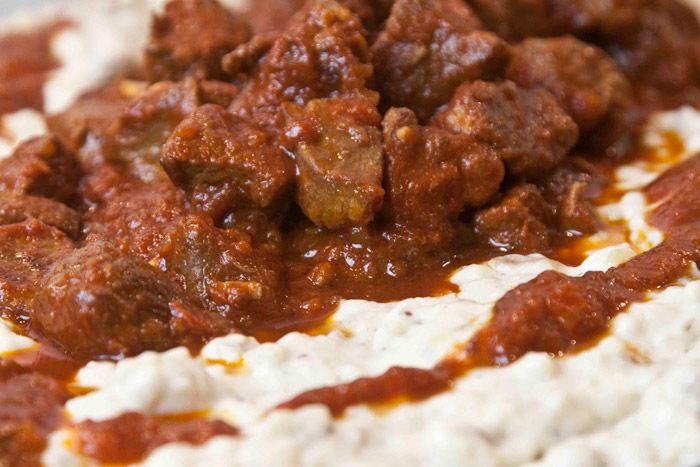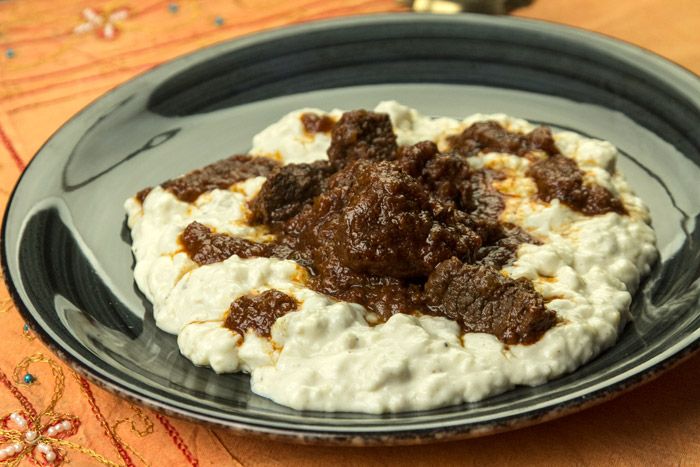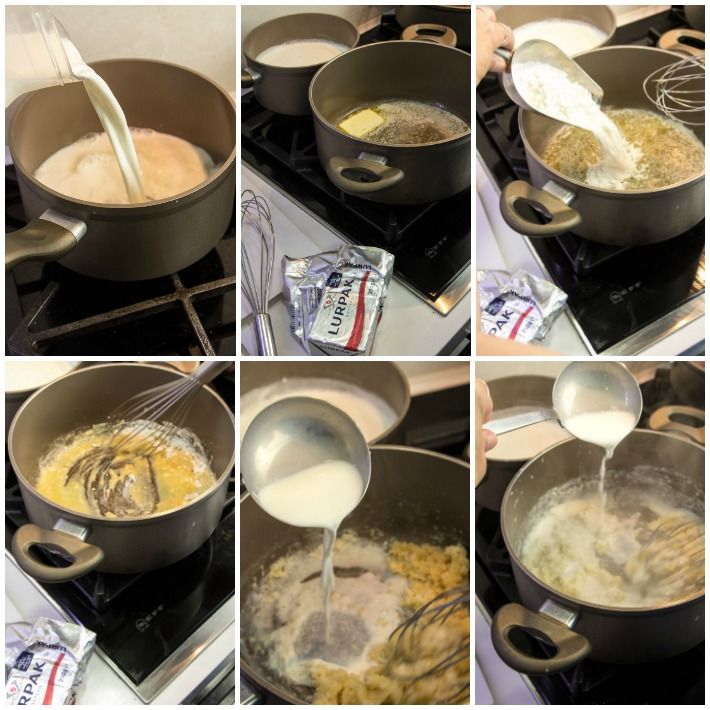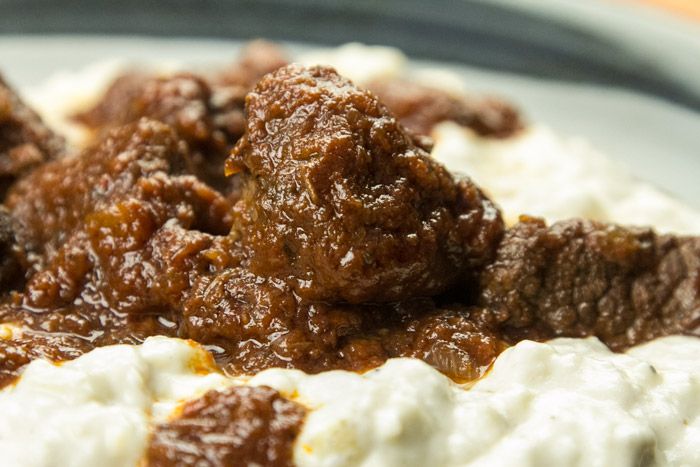Hünkâr Beğendi means Sultan’s Delight and is an amazing recipe for beef in tomato sauce served with aubergine purée which represents the culinary wealth of the Eastern Mediterranean cuisine. Hünkâr Beğendi is definitely in my top 10 of Greek recipes and is very often my choice of main course, especially when we entertain foreign guests at home.
I find that Hünkâr Beğendi plays between the familiar and the exotic, with beef casserole being a common culinary currency for all Westerners, while the sweet acidity of tomato and the smoky aubergine creamy purée bring in the intense flavours of the Eastern Mediterranean to seduce our foreign guests. And what is more, this recipe has two fantastic theories about the origins of its name.
I love telling these stories around the dinner table, because storytelling related to food enhances the enjoyment of the food itself as it makes us travel back in time and place. After reading up various accounts from different sources, by combining dates and facts, I present you with these two theories for your dinner table entertainment.
The prevalent theory about the origins of Hünkâr Beğendi
The story of hünkâr beğendi (otherwise known as Sultan’s Delight) begins with Anastasia (ca. 1589-1651), the daughter of a priest on the Greek island of Tinos, who at the age of 15 was kidnapped and sold into slavery in the Grand Bazaar of Constantinople (Istanbul today). She was renamed Mahpeyker (Moon-faced, meaning beautiful and round faced) and ended up in the harem of Sultan Ahmet I. She was his favourite consort and later became his legal wife, taking on the new name of Kösem and giving the Sultan two sons.
After the sudden death of the Sultan, his successor was her son, Murad IV who was still a child.
Therefore, from 1623 to 1632, at which time Murad was old enough to take the reins of the administration, his Greek mother was the first woman to rule the Ottoman Empire, chairing the ministerial councils from behind a curtain, in the Great Hall of Topkapi Palace.
Murad, though still very young in 1632, proved to be an extremely strong leader who enforced stringent measures such as the banning of smoking, coffee and alcohol (ahead of his time!), obviously keeping such sinful and harmful pleasures for himself, judging by the fact that he died of cirrhosis of the liver in 1640!
It seems that Murad was a very difficult person to satisfy. As the son of a Greek mother, I can attest that even today, Greek sons tend to be raised like little princes, with every whim and fussiness immediately catered to! And so, when it came to food, his cooks were forced to look for original ideas for recipes in the West, where the foundations of French gastronomy were being laid at the court of Louis XIII (1601-1643).
 In Paris, Francois Pierre de la Varenne (1615-1678), considered by many to be the father of French gastronomy, had already had great success with a sauce which he later named béchamel in honour of King Louis XIV’s head steward, the Marquis Louis de Béchamel. Murad’s chefs in Constantinople, trying to satisfy their difficult boss with haute cuisine techniques, experimented with mixing the French béchamel they had just learned about, with smoky aubergine purée and serving it as an accompaniment to the classic lamb tas kebab, which was a lamb dish we might assume was a sure-fire winner in the palace since the arrival of the tomato in the Mediterranean in the middle of the 16th century.
In Paris, Francois Pierre de la Varenne (1615-1678), considered by many to be the father of French gastronomy, had already had great success with a sauce which he later named béchamel in honour of King Louis XIV’s head steward, the Marquis Louis de Béchamel. Murad’s chefs in Constantinople, trying to satisfy their difficult boss with haute cuisine techniques, experimented with mixing the French béchamel they had just learned about, with smoky aubergine purée and serving it as an accompaniment to the classic lamb tas kebab, which was a lamb dish we might assume was a sure-fire winner in the palace since the arrival of the tomato in the Mediterranean in the middle of the 16th century.
When the Sultan, for once, showed his obvious delight with the new dish in front of his agonized cooks, their relief was immortalised by their naming of the dish Hünkâr Beğendi, which freely translated means “the Sultan was delighted” .
Well, it wasn’t easy to satisfy a son raised by a Greek mother!
An alternative (spicy) theory about the origins of Hünkâr Beğendi
Another possible explanation for the name of this dish is the following. Years later, in 1869, Napoleon III’s wife, Empress Eugenia (or Doña María Eugenia Ignacia Augustina de Palafox-Portocarrero de Guzmán y Kirkpatrick, 16th Countess of Teba and 15th Marquise of Ardales, if you really want to know her full name!) visited Dolmabahçe Palace, the main administrative centre of the Ottoman Empire , to meet with Sultan Abdülaziz.

Sultan Abdülaziz, his bedroom and Empress Eugenia (upper row)
The Dolmabahçe Palace in Constantinople (bottom row)
At the 19-course official dinner in her honour (almost one course for each of her names!), she was served this dish and was bowled over by it. So, since the word hünkâr is a general word for leader, if this theory is the correct one, it could refer to the delight of either the Sultan or the Empress (conclusion: we will never know exactly, but it’s fun to speculate…).
In fact, Eugenia was so excited about the dish that she sent her aides off into the kitchen with special tools with which to measure the recipe accurately. But the Sultan’s cooks stubbornly refused to give them details, claiming that the success of the recipe was dependent on technique and ingredients rather than on strict measurements.
By the way, I’ve read that Sultan Abdülaziz was a well-known womaniser and hotly pursued Eugenia that same evening at the Hamam of the Beylerbeyi Palace where he had put her up. Who knows, he might have had the chance to say “hünkâr beğendi” about something other than food that night!
Whatever its origins, happily this exchange between Eastern and Western cuisines was completed later, when the secret recipe of Hünkâr Beğendi was leaked to the West, with the result that today it is considered an ambassador of Turkish cuisine, using beef rather than lamb, in international cuisine.
In Greece, Hünkâr Beğendi became known through the cuisine of the Greek community in Constantinople – a Greek-Turkish fusion cuisine known as ‘politiki cuisina’, and it is a staple on the menu of restaurants serving these dishes. It is easy enough to make at home with the right technique and good ingredients and is a real showstopper, as it combines the homely taste of beef casseroled with tomato along with the creamy texture and smoky aroma of aubergine purée – a combination bringing to mind Oriental decadent pleasures!
The recipe:
The process involves three distinct steps which if you do them simultaneously should take you about 2 hours. The wonderful thing about this recipe is that it will taste even better if you make the first two steps in advance, even on the previous day, and leave making the béchamel sauce until an hour before serving. This is an advanced recipe that requires care, but the result more than makes up for the effort. If doing it for the first time, follow the steps and notes.
Ingredients (for 6)
for the tas kebab (beef casserole)
1.5 kilos of beef stewing steak (or lamb for the original version of the recipe)
2 small onions, finely chopped
50 ml extra virgin Greek olive oil
150 ml red wine
200 ml boiling water
5 bay leaves
1 stick of cinnamon
3-4 parsley sprigs tied with twine
½ tsp. chilli flakes
1 tsp. sugar
400 g chopped tomatoes
100 g tomato paste
Salt and Pepper
1 lt hot water or beef stock
for the aubergine purée & the béchamel
4-5 aubergines
100 g butter
100 g plain flour
150 g single cream (optional)
1 litre full-fat milk
½ tsp. grated nutmeg
100 g grated cheese (choose cheddar or emmental or another sweet tasting mild cheese )
Salt and Pepper
Preparation:
 1. Prepare the tas kebab (beef casserole):
1. Prepare the tas kebab (beef casserole):
Cut the meat into very small bite-sized cubes of 1.5-2 cm. and dry them with a kitchen paper towel.
In a large, wide-bottomed pan, heat the olive oil on a high heat setting and, once it is very hot, add the meat (you’ll usually need to do it in 2-3 batches for this amount) in order for it to brown and to caramelise on the outside.
Note: If you fill the pan with all the meat in one go, the oil temperature drops and instead of browning it will boil, and lose all its juices.
Don’t stir the meat too much, just turn each piece over after 3 minutes and wait for it to brown on the other side. Once this happens, give one last stir to make sure all the pieces have browned on all sides as this will ensure the maximum of flavour. Each batch will need about 6-8 minutes. Each time, remove the meat with a slatted spoon and let the oil heat up again for a minute before adding the next batch.
Once you have finished with the meat and have put it in a bowl, add the chopped onion to the remaining oil in the pan and lower the heat for 6 minutes until the onions are browned. You can now add the bay leaves, cinnamon and chilli flakes. Tip the meat back into the pan, pour in the wine and the parsley. Leave it to simmer for 15 minutes on a medium heat to reduce most of the wine.
Note: If you are not sure about the tenderness of the meat you bought, it is better to add ½ a litre of hot water at this stage along with the wine, to let the meat simmer for 30′ before adding the tomato.
Now you can add the chopped tomatoes, tomato paste, sugar, ½ a litre of hot water and salt and pepper.
Stir and leave to simmer for about 1½ hours, adding hot water until the meat becomes tender. When the meat is tender, the sauce has thickened and the olive oil has separated from the rest of the sauce in the saucepan the food is ready. After it’s done, remove the parsley, cinnamon and bay leaves and throw them away.
Note: If you cook the meat in advance, leave it at this stage to cool and put it in the refrigerator to let the ingredients mingle and the flavour develop and then take it out 2 hours before the final cooking and heat it through gently with a little hot water added to it.
2. Prepare the aubergine purée:
Wash the aubergines, dry them and then sear them directly over the naked flame of a gas ring or culinary torch, touching them to the flame to sear them and get a gorgeous smoky flavour and aroma.
Note: If you do not sear the aubergines over a naked flame and use an electric hob or grill instead, you will not get the intense smoky flavour that makes all the difference to this recipe.
Each aubergine takes about 6-8 minutes of searing, until the skin shrivels and its juices begin to run.
 Once they reach this stage, remove them from the heat, let them cool down and then, under running water, remove all their skin so that only the flesh is left. Alternatively you can skin them with a sharp knife and kitchen paper to rub off the small remaining blackened bits of skin. Remove the stalk and most of the seeds from the flesh and then, with a good knife, finely chop them into very small pieces.
Once they reach this stage, remove them from the heat, let them cool down and then, under running water, remove all their skin so that only the flesh is left. Alternatively you can skin them with a sharp knife and kitchen paper to rub off the small remaining blackened bits of skin. Remove the stalk and most of the seeds from the flesh and then, with a good knife, finely chop them into very small pieces.
3. Prepare the béchamel with aubergine purée:
Heat the milk in a saucepan. Melt the butter in another saucepan and whisk in the flour until fully combined. Turn down the hob setting to low and add the milk one spoonful at a time, whisking continuously to get a smooth texture.
Once the mixture starts becoming fuller and thicker, add the cream, nutmeg and salt and pepper to taste.
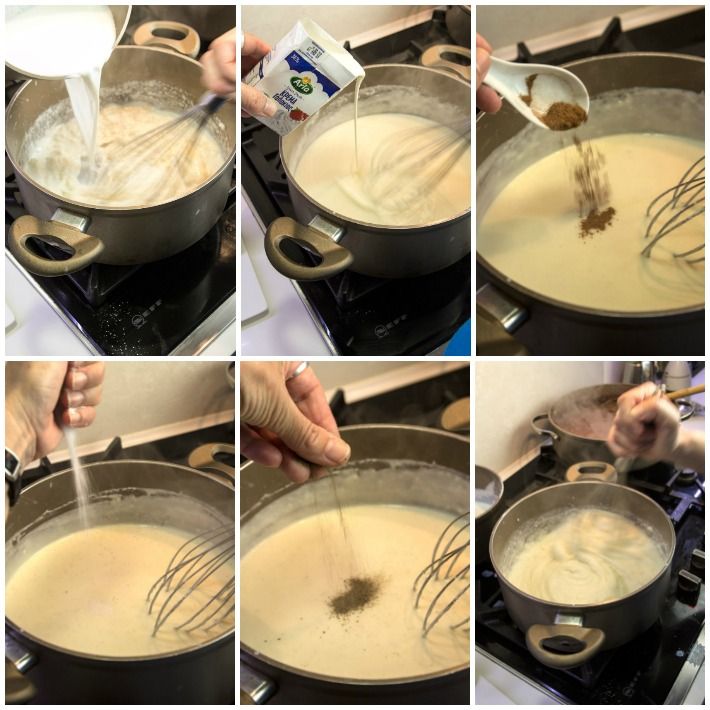
When the béchamel is ready (after 6-7 minutes), add the finely chopped aubergines and stir well. Finally, add the grated cheese, stir well and remove from the heat. If you need to keep the bechamel for some time put a cling film on its surface.
Serving:
Spoon the tas kebab onto the centre of a large platter or dish and then spoon the purée around the edges. You can then drizzle a little of the sauce over the purée if you want.
Now, bring on the belly dancers!



